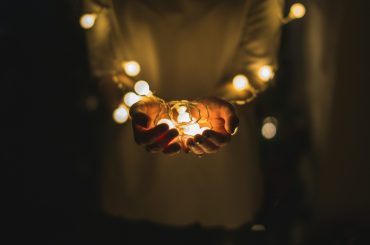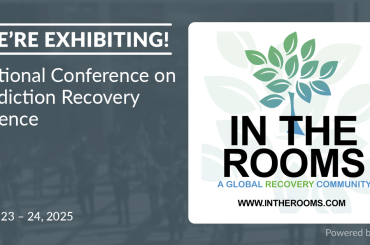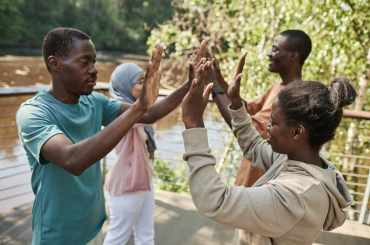What does Valentine’s Day have to do with yoga and recovery? Love, admiration, and relationships that are discovered within ourselves and with one another at meetings and other sharing. But occasionally we draw in advertising, movies, and other social media and experience sadness, loneliness, and, maybe, self pity. Sometimes we crave and contemplate what we are sure others have when we see the ads and the promotions for gifts and greeting cards. It can be painful. This celebration of chocolate and all things sweet can be a challenge when you are dealing with food issues. The illusion that “everyone else is in love” can bring up relationship issues. You may find yourself having to navigate the field of wants within yourself. How can you observe your life in a healthy way and enjoy the friendships you have? And you do have friends. We, in recovery, can find friendship.
Partnership, a trusting relationship between people or within yourself, a collaboration, a cooperation, connection. These are the basis of love, genuine love, authentic love. They also contribute to romantic love which is the kind most often celebrated on Valentine’s day. From the time of Claudius when marriage was prohibited due to the romance and longing it created in his soldiers, to the present day where we note an excess of flowers, candy and expectations Valentine’s day is celebrated from kindergarten to the last stages of life.
How about letting go of expectations for cards, gifts or acknowledgement and give attention, support and community to those you care about? Here is a way: partner yoga. This is a wonderful way to both provide and receive support. It is a way to have fun, laugh and explore the joy of companionship. It can be romantic or platonic. It can be an enjoyable way to spend time together without sugar and without a lot of money.
Grab a friend and try it! Here are some poses that can be enjoyed with a partner. You don’t have to be the same size, have the same flexibility or the same experience level in yoga. You do need compassion, care and a sense of humor.
As with all yoga poses, please listen to your body sensations and honor your feelings. Avoid over doing; partner work can be both easier and more difficult. Look for the medium way, letting go of extremes. Put your expectations aside; draw on your principles of practice not perfection, and use your yoga breath
Make a commitment to listen and to communicate. Let your partner know how you are doing; listen to what your partner is expressing. Once you have arranged yourself into a pose take 3 full breaths.
Let’s begin.
Back to back cross legged pose – settle into the seated pose, breath, align and center yourself.
Cross legged forward fold / back bend heart opener. Arms outstretched from shoulder- one partner has arms over the other’s. Bend forward as partner bends back. Three full breaths, then reverse the stacking of the arms and fold again.
Back to back extended leg forward fold / back bend. First sit upright leaning back to back. Decide who will fold forward and do so. Partner leans back. If you wish the partner leaning back can bend knees, plant feet on the floor and rise up to a reverse tabletop pose. Exchange after 3 breaths.
Wide legged forward fold. Turning around face one another and send the feet out to find a “V” position. Person with shorter legs or less flexibility will place their feet on the partner’s ankles or calves. Reach arms forward and grasp one another’s arms above (not on) the wrist. One partner will lean back the other will fold forward. Hinge from the hips, where the legs meet the torso, rather than from a rounded back. Your spine will thank you. Three slow long breaths here. Reverse.
Back to back cross legged twist. Spin around again and sit back to back in a cross legged position. If this doesn’t work, try butterfly; soles of feet together and knees out to sides. Try this pose a few times (you can’t OD!) and find out what works for you.Twist to the right first, taking your left hand to your OWN right knee and reaching around grasp your partner’s right knee. Yes, it is confusing as you are back to back and twisted around. Find a comfortable twist. Breath. Unwind and reverse this.
Stand up. Try doing this by sitting with bent knees. feet on the floor close to one another. Reach forward and grasp each other’s forearms and help each other rise up. Don’t worry if you falter. This is just for play.
Weeping Willow side angle (trust) pose. Stand side to side, facing forward, a small distance apart such that your fingertips can touch your partner’s elbow. (This is art not science so be flexible with the distance.) Loosely hold one another’s arm just below the elbow and lean to away from them letting your hands slide down the arms to the wrist and HOLD there. You are now in a side arc and can let your head drop to the outside arm, which is reaching out shoulder height. Take your full three breaths, then lift your head before you pull yourself back you to vertical. Switch sides.
Forearm hold chair pose. Face one another about a foot apart (size and flexibility will impact the distance.) Grasp forearms and lower into a chair pose. Hold this pose for six full breaths. Carefully come up. Release.
Side to side tree pose. Stand close to one another, perhaps a foot apart. Balance on both feet, then transfer weight to inner leg, coming to the ball of your outer foot. Turn the knee of that foot out and lift the foot to calf or thigh. bring the arms forward and up, wrapping your inner side wrist around each other providing support and strength in the pose. Outer palm faces the inner-vined hands. Breath and remain here as long as you feel comfortable. Check in with your partner, communicate and reverse to standing pose when done. Change sides and repeat.
Decide if you want to do this sequence again before your final two poses.
When you feel complete please sit back down on the mat.
Straight leg forward fold / back bend. This is the same pose as above. Sit back to back with legs outstretched and without going into the table top option, take turns in the forward fold / back bend pose. Take your time.
Savasana; integration and conclusion. Side by side, but with ample distance between you, lie down for tranquility pose. Arrange yourself in a back lying position, be sure your are comfortable and warm enough. Lie quietly for five full minutes. It is the most difficult pose, the one that says “enough”. Try to be there quietly, for your partner, for yourself. Use this as a 10th and 11th step opportunity if you cannot let go of busy-ness. Be kind.
This Valentine’s Day, give yourself the gift of breath and companionship, joy and laughter. Let go of expectations, and romance your new found freedom in sobriety and in health.
Namaste.
















4 Comments
Brilliant! Once again thank you!
Thank YOU! Be well
Enjoyed the article and it makes me want to go hunt down a yoga partner Thanks, Kathy
Thanks, Kathy
You wont regret it – Pal Yoga practice can bring out the playful side of yoga.